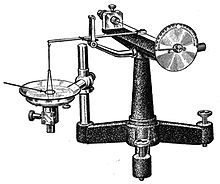- Du Noüy ring method
-
The du Noüy ring method is one technique by which the surface tension of a liquid can be measured. The method involves slowly lifting a ring, often made of platinum, from the surface of a liquid. The force required to raise the ring from the liquid's surface is measured and related to the liquid's surface tension.
This technique was proposed by the French physicist Pierre Lecomte du Noüy (1883–1947) in a paper published in 1925.[1]
See also
References
- ^ du Noüy, Pierre Lecomte (1925). "An Interfacial Tensiometer for Universal Use". The Journal of General Physiology 7 (5): 625–633. doi:10.1085/jgp.7.5.625. http://jgp.rupress.org/cgi/reprint/7/5/625.
External links
- Papers of Pierre Lecomte du Noüy, 1883-1972
- Movie showing a du Noüy tensiometer
- Picture of a du Noüy tensiometer (National Institutes of Health)
Categories:- Measuring instruments
- Laboratory equipment
Wikimedia Foundation. 2010.

